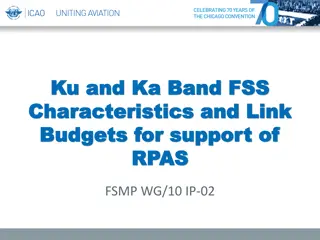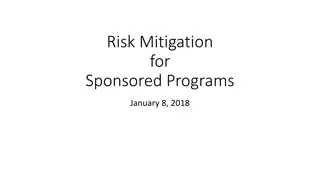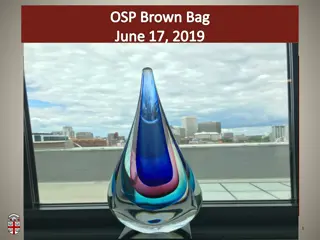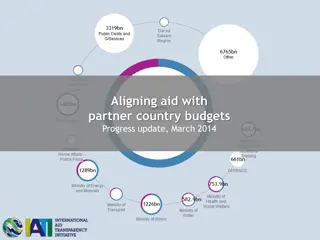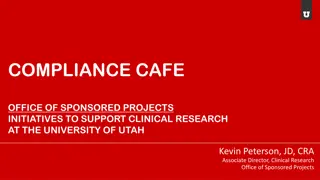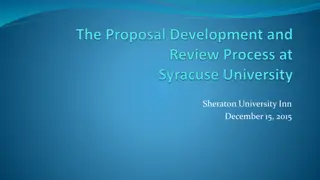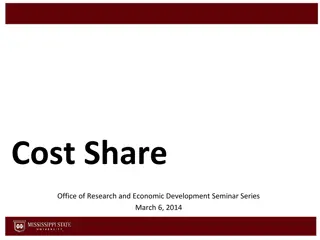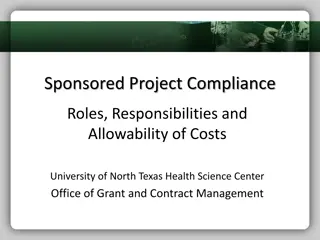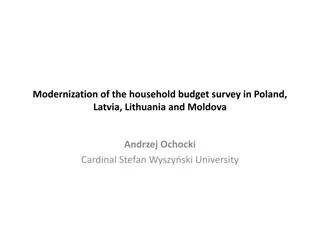
Effective Strategies for Sponsored Project Budgeting and Management
Explore key policies and principles for developing budget proposals in sponsored projects, including cost categories, salary structures, time measurements, and percentage of effort considerations. Enhance your understanding of allowable, allocable, and reasonable costs in sponsored awards to optimize budget utilization.
Download Presentation

Please find below an Image/Link to download the presentation.
The content on the website is provided AS IS for your information and personal use only. It may not be sold, licensed, or shared on other websites without obtaining consent from the author. If you encounter any issues during the download, it is possible that the publisher has removed the file from their server.
You are allowed to download the files provided on this website for personal or commercial use, subject to the condition that they are used lawfully. All files are the property of their respective owners.
The content on the website is provided AS IS for your information and personal use only. It may not be sold, licensed, or shared on other websites without obtaining consent from the author.
E N D
Presentation Transcript
SPONSORED PROJECT BUDGETS Behrend Grants & Contracts Office
PSU POLICY FOR BUDGETS RA21: Development of Proposal Budget https://policy.psu.edu/policies/ra21 General Cost Categories Direct Labor (salaries and wages) Fringe Benefits Other Direct Costs Facilities and Administration (F&A) Costs Inflation Factors Budget for work in a future time period Some costs increase every year of the project
PSU POLICY FOR BUDGETS RA10: Costing Principles for Sponsored Awards https://policy.psu.edu/policies/ra10 Only allowable, allocable, and reasonable costs may be charged directly to sponsored agreements Allowable: costs are necessary for the performance of the project; focus on the purpose of the charge Allocable: cost benefits this, and only this, project; if a cost benefits two or more projects, divide proportionally based on proportional benefit; document! Reasonable: costs are ordinary and prudent/market-driven Consistent: same criteria used for all costing decisions
TIME MEASUREMENTS Calendar Year: January 1 December 31 Fiscal Year: July 1 June 30 Academic Year: August 15 August 14 Fall Semester: August 15 December 31 Spring Semester: January 1 May 15 Summer Semester: May 16 August 14 Project Year: Based on Period of Performance (PoP) Generally measured in 12-month period from the Start Date of award
Faculty, Research Associate, Staff Annualized amounts based on appointments Category I: Salaries Category II: Graduate Assistants Stipends based on semester and grade SALARY: PSU CATEGORIES Category III: Wages Hourly rate employees Category IV: Student Wages Undergraduate students only Annual appointments with fixed salary Category V: Postdocs
SALARY: PERCENTAGE OF EFFORT Salary budgets are based on the percent of time/effort the PSU employee will spend on the project Academic vs Summer months Annualized = 48 weeks Examples: AY: 1 week per month for 9 months = 9 weeks/36 weeks = 25% AY effort SU: 3 weeks per month for 3 months = 9 weeks/12 weeks = 75% SU effort Annual: 2% effort per year = 48 weeks x .02 = ~1 week
SALARY: SUPPLEMENTAL PAY & COURSE RELEASE PSU Policy HR06 Types of Appointments https://policy.psu.edu/policies/hr06 Supplemental I: Full-time 36-week contract faculty can earn a maximum of 1/3 of their base 36-week salary for all activities processed through Penn State, including sponsored research, teaching, and administrative duties. Certain federal sponsors may place additional limits on summer compensation. Supplemental II: During the academic year, faculty on a 36-week contract are eligible for up to 20% extra compensation from all sources processed through Penn State. Course Release: Faculty who are requesting course release to pursue research must have approval from School Director. The cost of release time is determined by business unit s policy.
Pay rates for salaried employees increase each year For budgeting purposes, average inflation rates are used Cat I Salaries: 4.0% effective 7/1/23 Cat II GA Stipends: 4.0% effective 8/15/23 Cat V Postdocs: 4.0% effective 7/1/23 Tuition: 4.0% effective Fall semester 2023 SALARY: INFLATION Wage budgets are based on fixed hourly rates and are not inflated each year
FRINGE BENEFITS In addition to salaries or wages, PSU employees also receive fringe benefits Fringe benefit costs include: Health Insurance Workers Compensation Life Insurance Social Security/Medicare Retirement Educational benefits Fringe benefits are budgeted as a fixed percentage of the salary or wage budget
TRAVEL TR02: Penn State Travel Policy https://policy.psu.edu/policies/tr02 TRAVEL Documentation should be maintained clarifying why an individual person is traveling, why the travel is necessary, and how it benefited the project. Travel budgets should be itemized by trip and include purpose, destination, number of travelers, and length of trip. At a minimum, budgets should include estimates for commercial transportation and government rates for lodging and per diem Lump sum travel budgets based on PI prior experience should be validated
SUPPLIES & MATERIALS/EQUIPMENT Cost Accounting Standards FAQ https://www.research.psu.edu/sites/default/files/CASBFAQ_0.pdf Supplies Equipment Laboratory supplies are generally allowable as direct costs, as long as they are being purchased for use on a specific project. Office supplies are generally not allowable as direct costs, since these costs are recovered via the university s collection of F&A. Items of equipment equal to or exceeding $5,000 and having a useful life of one (1) or more years. (Per RA21) Proposal documentation should include a vendor quote.
COST SHARE RA 50 Cost Sharing https://policy.psu.edu/policies/ra50 COMMITTED MANDATORY COMMITTED VOLUNTARY UNCOMMITTED MANDATORY Required as a condition to receive an award and specified by the agency in the proposal guidelines or program announcement. University expenses, such as faculty salaries, over and above that which is committed and budgeted for in a sponsored agreement. Not required by the sponsor, but committed by the University through inclusion in the proposal as a commitment. Documented in the project proposal (e.g. budget or budget justification) or the narrative. This commitment could appear in the proposal (e.g. budget or budget justification) or the narrative. Must not be documented or accounted for as part of the award.
SUBAWARDS & SUBCONTRACTS Identify individual sub-awardees and the total estimated cost for each The following items should be provided by each sub-awardee: Itemized Budget & Budget Justification Statement of Work Letter of Commitment with authorized signature Indirect Cost Rate Agreement (if applicable)
FACILITIES AND ADMINISTRATIVE COSTS (F&A) F&A costs (indirect costs or overhead) are expenses that are essential to the conduct of sponsored awards but which cannot easily be directly charged to specific individual projects. If a majority of the salaries and wages (including Penn State cost-share, excluding subrecipients) are incurred on-campus, then the on-campus rate will apply to the entire project. If a majority of such costs are incurred off-campus, then the off-campus rate will apply to the entire project. More information: RA30; specific examples can be found in Q4 of the F&A FAQ Fringe Benefits and F&A Costs | Research at Penn State (psu.edu)
F&A RATES Rate Summary Sheet https://www.research.psu.edu/Rate_Summary_Sheet
F&A EXCEPTIONS The Federal government s position is that revenue raised via the federally negotiated F&A rate should not be used to subsidize research performed for private companies and foreign governments. Exceptions to recovering full F&A: If a sponsor is a not-for-profit or governmental [non-foreign] entity and has published guidelines prohibiting or limiting the recovery of F&A costs. When Commonwealth of PA projects are funded solely with state funds, the University will charge the amount permitted by the state agency. The University waives the recovery of F&A costs on all gifts since there is no "deliverable" required. Approval from the Senior VP for Research or Associate VP for Budget & Finance will be required to waive recovering full F&A in most other situations.
F&A RATE CALCULATIONS Excluded in F&A Included in F&A Salary/Wages Equipment Fringe Benefits Tuition Stipends Supplies Participant Costs Travel Subcontracts over $25,000 First $25,000 of subcontracts
Purpose Document and communicate how the project s cost estimate was developed Provide supporting data to validate estimates and calculations Identify assumptions and constraints which pertain to the project s cost BUDGET JUSTIFICATION Format OSP template: https://www.research.psu.edu/node/737 https://www.research.psu.edu/node/737 Include clips of spreadsheet calculations and other supporting data used to develop budget estimates
SAMPLE BUDGET Budget ID: 104461



